#-> then the wanderer wikipedia page like i was on a rabbit hole bc wander is like a sovereign like it’s a nationality i guess girl i dont
Explore tagged Tumblr posts
Text
me realizing that the slang term i’ve used to say ‘get scammed’ a) isn’t spelled that way & b) is actually a slur

#stream#waterboarding myself#girl i-#if i wasn’t getting extremely fucking high immediately after this realization i would’ve felt worse but now i feel nothing period#like i’m D:#but i’m literally ����️_👁️#i’ve used it so often i thought it was spelt w a FUCKING J SINCE I WAS LIKE 5#why did i think abt this bc ok ive started analyzing the slang i use bc i’ll use an adjective & im like i would’ve never fucking said that#in america#like plump & for what was this other 1 hold on#SHODDY ?#i mean i think i would’ve used that in the us but idk why google had ‘is shoddy british slang’ like no ?#soddy probably#oh then i was like ok wait why do u spell it Like That#Wait … WAIT ? OH MY GOD ? <- THE HORROR OF ME REALIZING I WASNT SPELLING IT CORRECTLY#& THEN HOW ITS ACTUALLY SPELT -> D:#-> then the wanderer wikipedia page like i was on a rabbit hole bc wander is like a sovereign like it’s a nationality i guess girl i dont#remember specifics i’m baked as fuck we’re broad stroking it#but then it ties to the romani people & then i went … oh the slur … OH THE STEROTYPES …. OH MY GOD MY SLANG ???????#i’m still like •_•#girl …#u were such an asshole accidentally for 25 years#remembering the time specifically in junior year ap us history & we had to make this stupid ww2 music video girl i don’t even know why idk#if it was even supposed to be abt ww2 but we were ww2 & we were told by our teacher we couldn’t shorten japanese that way bc that is a slur#& we were all like •_• •_• •_• •_• oh#bc it was the 4 of us in the group#& then i remember when kp found out this slur for chinese people is a slur bc apparently there’s a specific adjective they use to describe#people u Cannot Say Here Idk Abt India But Definitely Not Here & also he then found out what ‘slur’ means bc he didn’t know that word either#ALSKKSKLKSLKALLSLLAKSLALDKAKSSK oh my god that trip was a mess#i fucking hate scotland
1 note
·
View note
Text
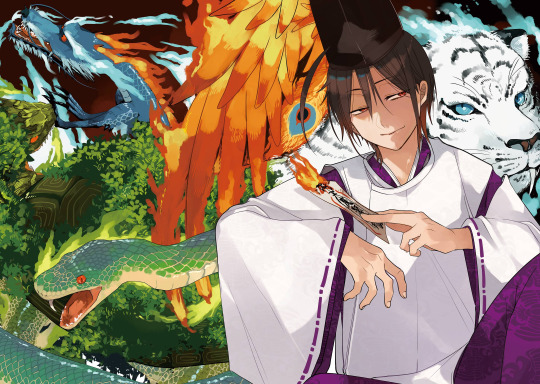
The Kyoto Arc Analysis Post (Part 1)
In other words, “OP has been consumed by wikipedia rabbit holes for the past 3 months”
Starting writing this in September, now it's November. Also this thing is nearly 7000 words.
TLDR: This is basically a crash course on ancient Kyoto, the mythology then, and stuff that details in this arc points to. Chinese philosophies and mythology are mentioned too, when relevant.
Spoilers for chapters 82 to 94.
I keep hitting image limit so this has been split into multiple posts
This part covers the urban planning of ancient Kyoto, what the four gods are, and some locations shown in ch 83.
Part 1 / Part 2 / Part 3 / Part 4
(If you want to read the whole thing in a google doc, here's the link)
Warning: I’m not a historian, just some rando on tumblr, I’ll probably get some details wrong. If you have anything to add or anything to correct, please do, also don’t get too mad at me.
Also, if this shows up in the searches for some of the other mangas I namedrop, I’m sorry!
If there’s a concept you’re interested to know more about, just google it. I’m bound to leave out stuff bc not everything is relevant (and there’s already plenty of irrelevant stuff in here sobs), people write whole books about this stuff, I’ll be here for 1000 years if I were to bring up all of it.
I Don’t Know How To Start This
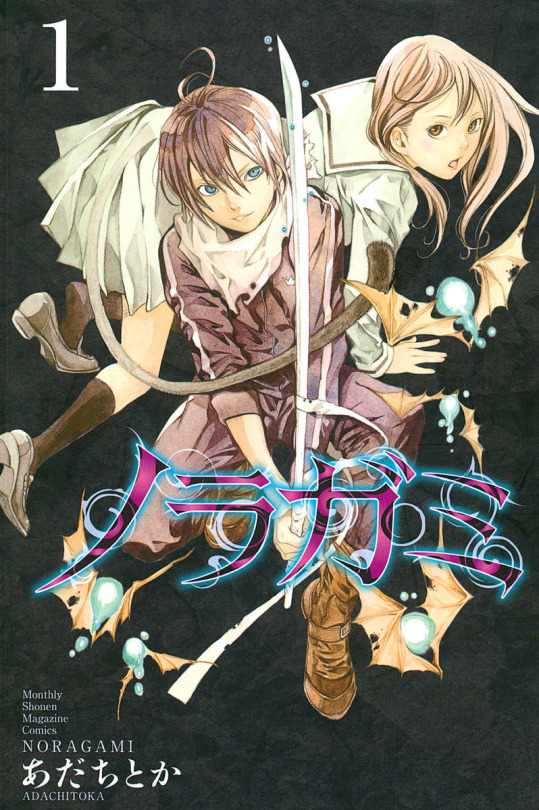
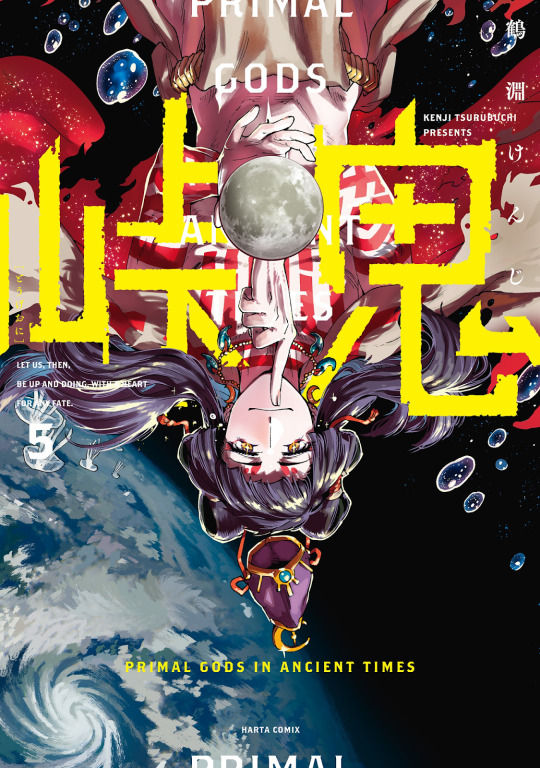
I guess I’ll recommend some other manga that have to do with gods, Shinto, that stuff.
Well. Everyone knows what Noragami is. If you don’t, go read/watch it. If you do, go read/watch it again. It’s probably better than you remember it being. That’s the curse of monthly manga, it feels like there’s pacing problems when you read it once a month, but usually when you binge it you find it’s structured pretty well. Strangely I don’t find this with youkaigakkou, but maybe because I think about it 24/7.
Touge Oni, or “Primal Gods in Ancient Times”. This manga leans heavily into ancient Japan, Shinto creation myths, stuff like that. Tonally it’s kind of like Mushishi, in the way that powers beyond human comprehension just do crazy shit. Anyway, great manga, highly recommend.
Wow, The Actual Manga, Right
Just some trivia to start with. This is going to wander quite a bit, because there’s a lot about history and mythology, which means everything is connected to everything else. You know how it is.
Shinto shrines are called shrines, 神社 -jinja, meaning “place of the god(s)”
Buddhist temples are called temples, 寺 -dera or -ji.
The temple they’re staying at is called “Bonnou-ji”, or "worldly desires temple". As far as I can tell, this isn’t a real place, nor could I figure out what temple it’s based on just from the scenery we get to see. (We don’t even get a general location of what part of Kyoto it’s in.)
Heian-Kyo
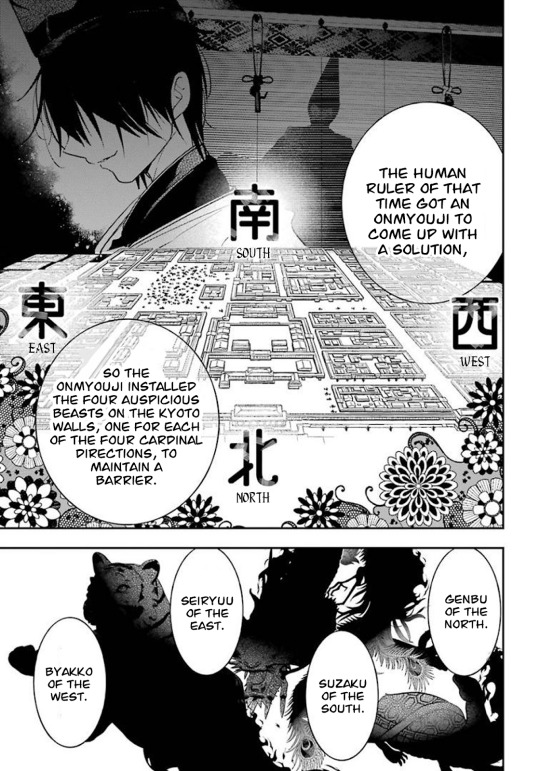
You may have noticed South is oriented at the top on this page.
I have a guess, but I can’t be sure it’s right.
Why does it matter? First of all, we have to talk about the other thing Seimei mentions about Kyoto: It’s built in a grid.

(By the way, this is an insane thing to say. What does he mean?? Does he mean “ah yes city was built like this over 100 years ago so one day someone could use this specific spell involving a grid to subdue a giant booba monster”?)
Also, the word he uses for “grid” here is “碁盤目 (gobanme)”, which in the literal sense means “shaped like a Go board”, which is cute. I want to see them play Go.
Heian-kyo (the name for Kyoto back then), like Japan’s previous capital of Heijo-kyo (now Nara), was modelled after the Chinese capital of Chang’an (now Xi’an).
For the record, they probably didn’t call themselves “Heian-kyo” back in those times, and started calling themselves Kyoto around the 11th century. It’s kinda like how we call it “ancient Japan” but they didn’t call themselves that. To them it was just “now” and “the capital”. Why make a name for “the capital” when there’s just one capital that will be capital forever? Makes sense.
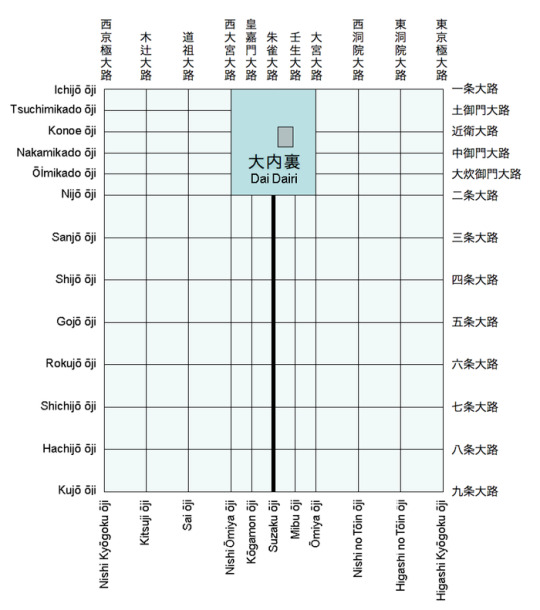
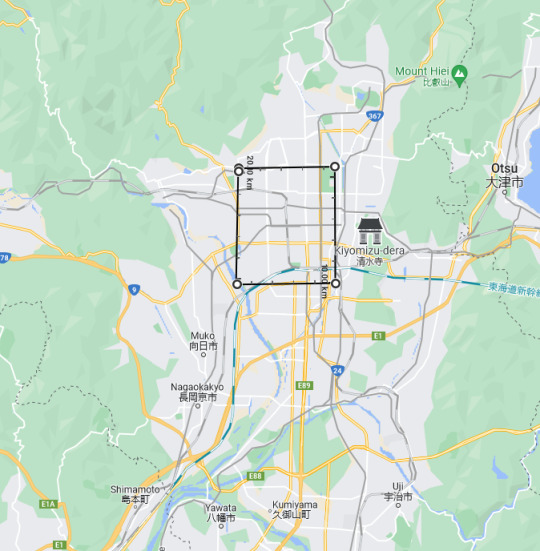
(Just for reference, the layout of the streets and where Heian-kyo would be compared to modern Kyoto.)
The emperor’s palace is in the northernmost part of the rectangular city, with the main street Suzaku-oji going down the center of the city to the southern gate.
The reason behind that is the idea that left (east) is more important than right (west), and that the emperor should sit with his back facing the north star (Polaris), so that the sun rises from the left (east) and sets on the right (west).
What Heian-kyo and Chang’an are both based off is the urban planning fengshui idea of “shijin-so-o”, which translates to “four gods topography”, which is the very same four gods we’re talking about this arc.
There are two very similar versions of this philosophy, the original one and the one derived from that.
The original version is based off the idea of “zofu-jusui” meaning storing wind and water. There is to be mountains in the North, hills in the East and West, and a body of water in the South, creating a sort of jug.
The expanded version is:
Seiryuu to the left, flowing water in the East Byakko to the right, thoroughfare in the West Suzaku to the front, lake in the South Genbu to the back, mountains in the North
Basically, a city is to be bounded by mountains in the North, a river in the East, a road in the West, a lake to the South. Also, again, left and right in this definition is based off the emperor’s perspective, which could explain the direction labelling on that page.
In any case, both of these definitions apply to Kyoto.
Also, Chinese maps traditionally were oriented with south at the top, I can't say for certain if Japanese maps did too, but it's likely!
However, if you look at maps today, you may find that there’s no major body of water south of Kyoto.
In the past, there used to be the Ogura-ike pond south of Kyoto, which symbolised Suzaku. (Despite being called a “pond”, it was more the size of a lake, 4km by 3km). In the 1930s, it was filled in because of land reclamation, to create more farmland.
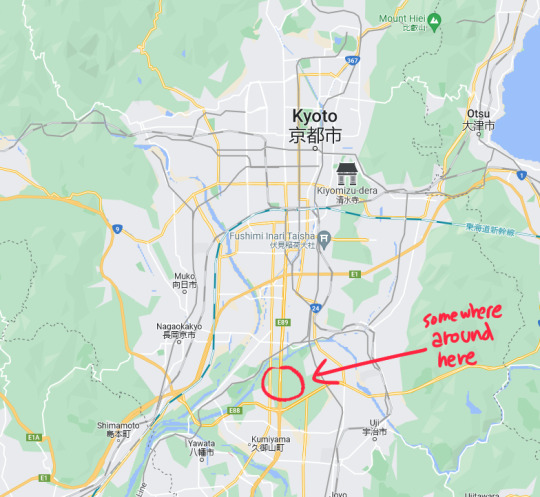
In a sense, Kyoto had “lost Suzaku”.
Intermission
It’s also BECAUSE of this very philosophy that Kyoto nowadays gets abnormally hot in summer (above 35 degrees celsius for 15 days a year on average, compared to 5 days everywhere else).
Because it’s inland and blocked by mountains on all sides, on hot days, cool air can’t flow in from elsewhere so it just keeps getting hotter. Sounds like a stupid trade-off for stupid philosophy, but the practical reason behind the philosophy was probably that surrounded by mountains, Kyoto would be harder to invade.
Suzaku-oji
The main street, Suzaku-oji, also gets its name from the four gods. The main entrance to the palace, connected to Suzaku-oji is also called Suzakumon, or Suzaku Gate.
Speaking of Suzakumon, it shows up in the manga!
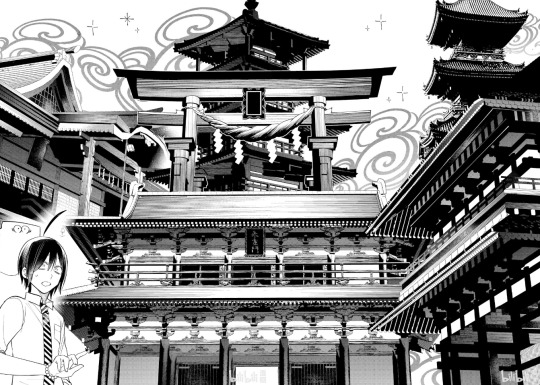
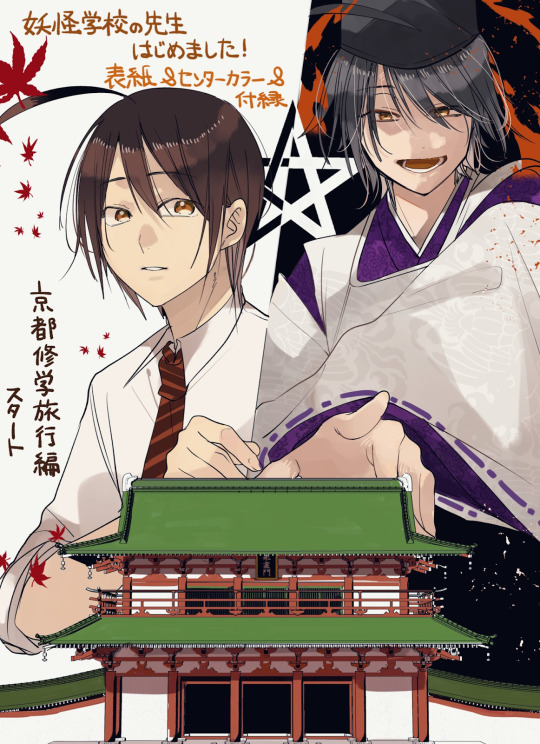
It’s where Byakko brings the gang when they go to the Seimei shrine. (Albeit a surreal version) The text on the plaque over the door is hard to read on this manga page, but it’s clear in this chapter promo art.
I believe it’s also where Shutendouji appears in ch 89. The text over the door is even harder to make out, but the building itself looks just like in that promo art.
Back to Suzaku-oji. Looking at modern Kyoto, you may notice that there's no major road down the center, instead there’s that major road to the right (in yellow). Zoom in! Enhance! What’s that road called!
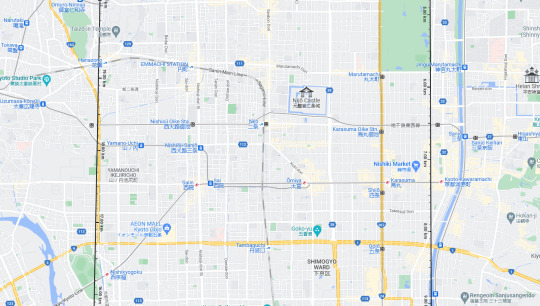
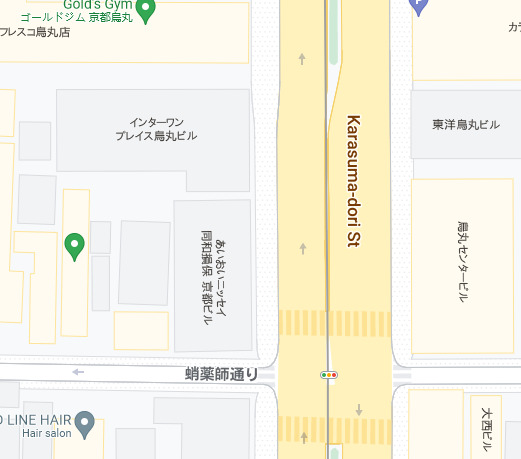
Karasuma-dori street. Corresponding to Karasuma-koji of Heian-kyo, and has replaced Suzaku-oji in modern times as a main street of Kyoto. You know, like Karasuma Ranmaru. (launches myself out the nearest window)
So anyway, what gets me hung up about why south is at the top in that page, is that it just does not correspond to the map under it.
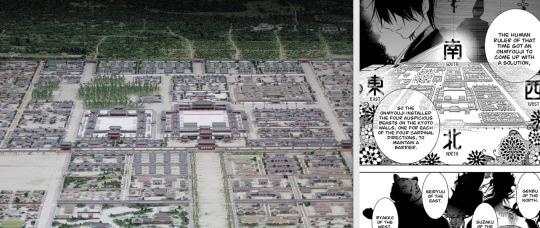
Left side is a miniature model of Heian-kyo, it’s basically a perfect match. And you can see Suzaku-oji right there on the miniature model, that big wide road, stretching from the palace gate towards the south, which would mean that south should be at the bottom of the page instead of north.
So why is it like that? idk

ALSO, IF YOU LOOK AT THIS PANEL FROM CH88, WHERE IS THE MAIN STREET???? This panel drives me insane. YOU KNOW WHAT THIS LOOKS LIKE? If you took that top half, the palace, and just pasted it at the bottom. And also the sides. DID THEY THINK NOBODY WOULD NOTICE? You know what they had a point. Canada “most sane yohaji enjoyer”, OP of this blog, who spent 2 months looking for sources on ancient Japanese and Chinese urban planning in 3 different languages, is an outlier and should not be counted.
What does this have to do with Kuji-kiri?
Honestly? I don’t know! There’s not a super obvious connection.
Kuji-kiri is the grid thing Douman does, “kuji” means nine words, “kiri” means cut. It’s a version of the kuji-in (nine hand seals), where the kuji-in is nine hand signs paired with nine words or phrases, the kuji-kiri is 5 horizontal and 4 vertical lines, drawn alternating, starting with a horizontal line.
It’s said to be derived from the principle of yin-yang in Taoism, which Onmyoudou as a whole comes from. (Onmyou and yin-yang use the same kanji)
Specifically, the 5 horizontal slashes are yang and offensive, the 4 vertical slashes are yin and defensive.
Worth mentioning, Onmyoudou also incorporates the philosophy of gogyo (five elements). Will elaborate on that later.
9 is a symbolic number in Taoism, said to be the perfect number in divination for yang, or the nine planets, or the seven stars of the big dipper plus two guardian stars, believed to be the gateway to heaven. There is the most tenuous of connections here, in that 9 was an important number in Chinese philosophy, where an ancient Chinese urban planning guide states “9 li x 9 li squares” (“li” is a unit of measurement) and “9 vertical and 9 horizontal streets in the city”
To that end, I assume the connection is simply that Kyoto is grid = Kuji-kiri is grid.
Four Gods
Four gods, auspicious beasts, symbols, guardians, whatever. The idea originated from China, and didn’t change all that much when they got to Japan. They don’t have this many names in Chinese, it’s just called “si xiang”. “Si” means four. “Xiang” doesn't have a great exact translation.
Not to be confused with any other mythical figures that come in fours that China/Buddhism/whatever seem to love so much, for all that “four” is an unlucky number.
Like a lot of other Chinese mythical things, while associated with Taoism, the four gods didn’t really originate from any religion. In that sense, I think they occupy the same cultural space as Japanese youkai, in that while sorta connected to religion, they’re not the focus.
They’re not gods of any religion, so what are they?
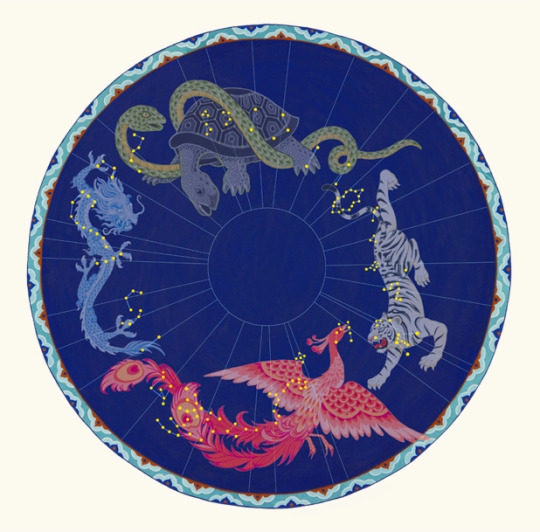
They’re constellations.
In Chinese astronomy, much like the western zodiac, the night sky is split into parts corresponding with the Earth’s position throughout the year. (Albeit, based off the moon rather than the sun.)
The night sky is split into 4 quadrants and 1 middle section, the middle around polaris symbolizing the emperor, and each quadrant is one of the four gods.
As said before, this is relevant because it’s part of the fengshui stuff behind the layout of Chang’an, which was inherited into the layout of Heian-kyo.
What does this have to do with Abe no Seimei?
Well. Onmyoudou is just divination, which is just astrology.
The four gods are very much tied to the Gogyo (five elements), which is half of the basis of Onmyoudou (the other half is yin-yang).
We know it's specifically the Taoist Gogyo and not the Buddhist Godai (another thing with 5 elements), because Seiryuu specifically says his domain is “wood” and “wood” is not present in the Godai.
If you’ve seen other media with Abe no Seimei, you may have heard of the 12 divine guardians (or divine whatevers, you get the idea). They’re shikigami employed by him, four of which are these four gods. I’m not entirely sure if it’s these four gods themselves, or if they just share namesakes.
(Also not to be confused with whatever other figures in Buddhism/whatever that come in twelves)
These 12 divine guardians also each correspond to a direction and the Chinese year zodiac.
The idea of the four gods is oddly extremely tied to Abe no Seimei, I assume because of the astronomy and astrology connection, so much that the gate to the Seimei shrine is the “shijinmon” or “four gods gate”, and also the pillars with the four gods carvings that show up in the manga as well.
Abe no Seimei tangent! According to legends, Abe no Seimei's mom was a white fox, Kuzunoha, often considered a youkai, but also sometimes said to be the envoy of a god or is a god herself.
In other words. What I’m trying to say is. I want to see fox Haruaki. (OP's worldly desires)
Also, look at this fun story about how Seimei died.
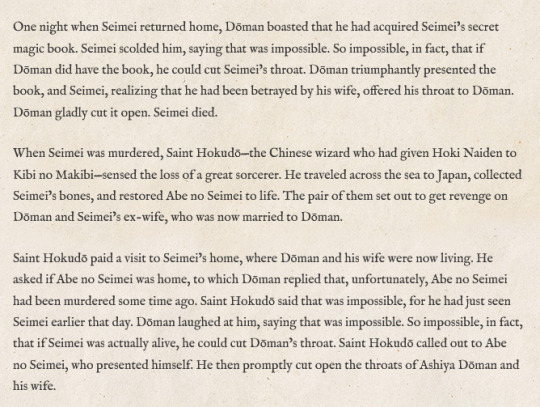
Tbh, I don’t know how much of this is common knowledge. I’ve seen a pretty big variety of people reading youkaigakkou, from people who are hearing about youkai for the first time to people who know absolutely everything about onmyoudou and onmyouji. I guess in this essay so far, the Abe no Seimei stuff is more towards the “everyone knows this” end of the spectrum and the Heian era urban planning is “who the fuck knows this”.
Youkaigakkou Geoguessr
That was a lot, so here’s me messing around on google maps for a little bit.

This panel was changed slightly in the volume release, but these are the Toji pagoda, the Fushimi Inari Shrine torii gates, and Kyoto Tower.
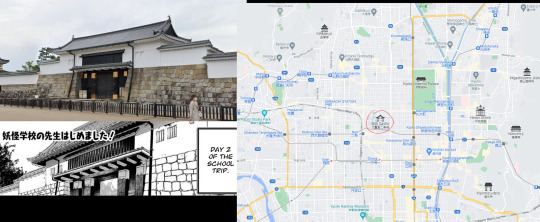
At the start of ch83, they’re at Nijo Castle.
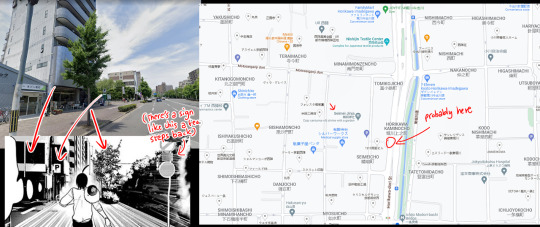
When Haru hears Byakko’s voice and runs off, this is probably where this panel is. I can’t get an exact angle from google street view, but it probably looks like the panel if you’re on the sidewalk. The parking sign, tree, and road sign line up almost exactly, and the building looks roughly right. (Seimei shrine also marked on the map for reference)
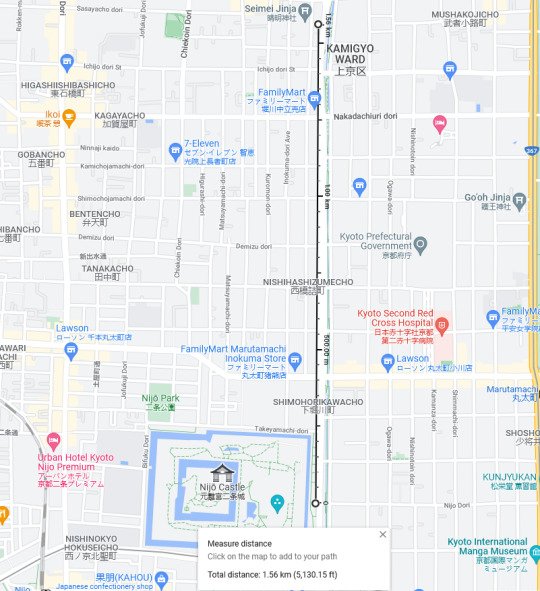
Mans casually sprinted 1.5km. You go king.
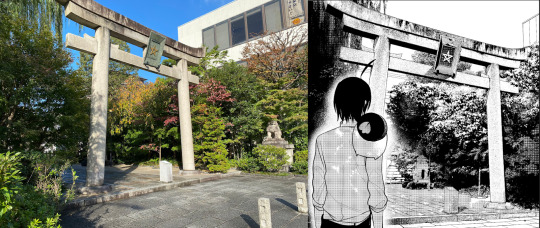
Seimei shrine is pretty cool. Sensei got to go there for photo references. It never really occurred to me how weird featuring real places in a manga would be, as cool as it always is, all the paperwork you probably have to do. (They have a link to apply for that on the website) They have a wall with Ema (wooden plaques) written by actors, authors, filmmakers and mangaka that feature the shrine in their works. I wonder if Tanamai sensei got to write one.
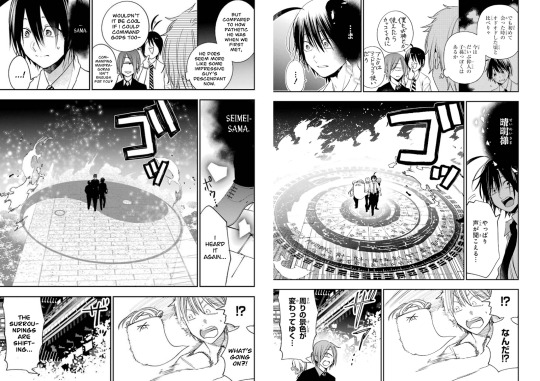
This page was also changed in a pretty big way in the volume release.
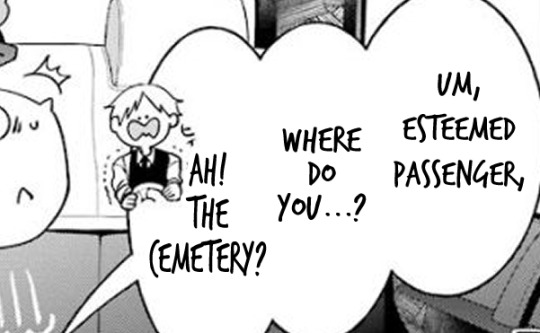
I mentioned this in my TL note, but this is referencing the reports of taxi drivers ferrying ghosts, especially after major natural disasters.

Yasaka shrine, roughly 3km straight line distance from Seimei shrine, 5km on the road. I’ll take the manga at its word as the closest Ebisu shrine lol. That panel in the manga specifically would be the west gate, which lines up with the road they probably took (straight south and then east).
The main deity enshrined there is Susanoo-no-Mikoto, but there’s a bunch of shrines on the grounds dedicated to different gods, one of which is to Ebisu.
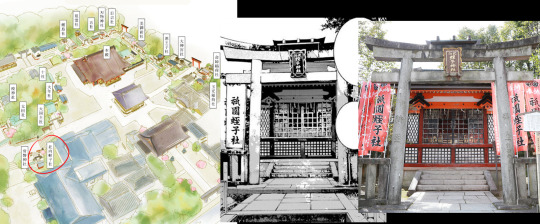
Specifically, it’s the “kitamuki-ebisu-sha”, or “north facing Ebisu shrine”. Because it… uh… (checks compass) faces north… I guess…? The interesting trivia about this is that Ebisu is written like “蛭子” instead of “恵比寿” (though it’s read as “ebisu” all the same)
蛭子 is more commonly read as “Hiruko”. (Anybody watch Summer Time Rendering here?)
Ebisu is thought to originate from the first child of Shinto creation myth big names Izanagi and Izanami, Hiruko, meaning “leech child” because he was born without bones, and was cast into the sea and floated ashore somewhere. In a popular version of the story, he washed ashore in Hokkaido, to be raised by an Ainu guy called Ebisu Saburou. (Or sometimes this guy is an Ainu deity? I cannot find a reliable primary source for this. This name comes up fairly frequently but I can’t pin it down.) I’ve also seen claims that “Saburou” is a generic name meaning “third child”, and since he is definitely the first child, that the “first two” are Izanagi and Izanami.
In any case, this would make him the older brother of Susanoo-no-Mikoto, who I’m not saying has any connection to any Mii-kuns we know of, but you know.
I got to the image limit, so the post gets split here.
Part 1 / Part 2 / Part 3 / Part 4
44 notes
·
View notes